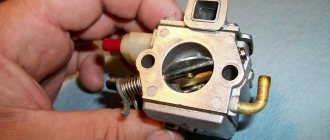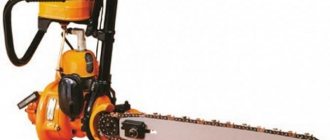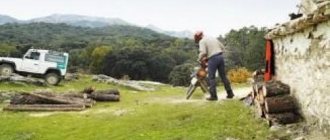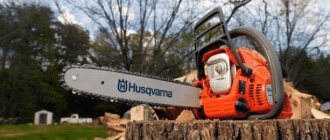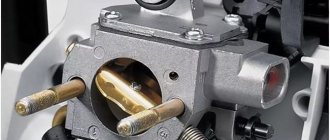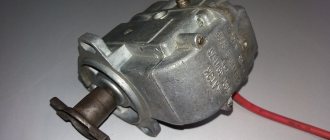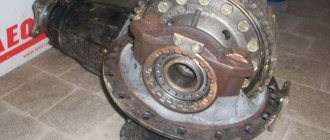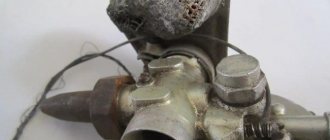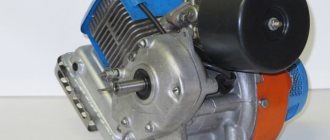Chainsaw Ural 3650 – parameters of the chain tool
This model with a modern layout is designed for intensive felling of dry and rotting fruit trees and active sawing of large dry wood.
The branded saw is equipped with a powerful reinforced gasoline engine, pre-equipped with a manual starting mechanism and a highly efficient system of continuous forced air cooling. Options:
- power – 4.96 l. With.;
- branded tire length – 45 cm;
- factory chain pitch – 0.325″;
- weight including cutting parts – 6.57 kg.
The Ural gas-powered tools in this original proprietary equipment are equipped with a high-quality inertial mechanical brake that protects the operator when the cutting set comes into contact with hard objects that cannot be cut.
Safety precautions
Important aspects specified in safety regulations cannot be neglected. Here's what is strictly prohibited when working with a gas-powered saw:
- Work without special clothing, safety glasses and gloves;
- Winding the cable around your hand;
- Touching the starting circuit with any foreign objects;
- Transitions made through a moving chain;
- Inaccurate oil filling and spillage of fuel into work areas;
- If the saw needs to be moved over a long distance, then its cutting part should be covered with a special cover. Otherwise, movement will be unsafe.
Protective gloves for working with chainsaws
It is also important to remember that by adhering to safety rules for working with a chainsaw, you can quickly and efficiently trim large trees, saw logs and prepare firewood for the winter
Malfunctions leading to improper operation of the chainsaw
There are a number of malfunctions that must be taken into account when diagnosing, since they can lead to interruptions in the operation of the saw.
- Wear of crankshaft bearings. If the crankshaft bearings are worn out, runout will inevitably appear on the main shaft where the flywheel is attached. In such a situation, it is impossible to adjust the gap between the flywheel and the ignition coil, which leads to interruptions in spark formation and unstable operation of the chainsaw.
- Impulse channel is dirty. The pulse channel serves to ensure the operation of the fuel pump; accordingly, its contamination will lead to improper operation of the pump, which will make it impossible for the saw to operate (it will start and immediately stall).
- CPG wear. As a rule, with increased wear of the CPG, a decrease in compression in the chainsaw engine is observed, which will certainly affect its ability to develop speed.
- Dirty fuel and air filters.
Replacing the ratchet on a Ural chainsaw
Another reason for a chainsaw malfunction may be severe wear of the ratchet, which is installed on the flywheel bushing of the chainsaw's crankshaft. As a result of such a problem, it is not possible to start the chainsaw engine, since the starter ratchet does not engage the chainsaw ratchet. To do this, disassemble the deflector, remove the crankcase cover, then unscrew the ratchet and replace it with a new one.
Photo-6. Removing the deflector.
Photo-7. Removing the crankcase cover.
Photo-9.Replacing the ratchet.
Chainsaw gearbox Ural
If, while sawing a chainsaw, the gearbox makes a grinding noise or other extraneous sound, then it is necessary to disassemble and inspect it. It is quite possible that one of the two bevel gears of the gearbox has failed. The gearbox should be disassembled from the side of the saw chain drive sprocket.
Photo-10. Removing the drive sprocket. For more detailed information about the operating rules and methods of disassembling a chainsaw, download the instructions. DOWNLOAD
Photo-11. Dismantling the driven bevel gear.
Photo-12.Replacing the driven bevel gear.
If increased noise occurs when the chainsaw is operating, this may mean that the muffler has been damaged. In such cases, the muffler should be replaced.
Photo-13. Replacing the muffler.
Photo-14. Unscrewing the M5 screw of the muffler.
Possible faults
Chainsaw owners sometimes face the following problems:
- A poor-quality saw, the chain bites heavily into the wood, produces a lot of fine wood dust, and grinds the wood down like a file. Reason: The chain is already dull; it needs to be sharpened or a new one used.
- There is a strong knock of the motor, the saw rattles in the hands under load and intensive work. Reason: the carburetor is not properly adjusted.
- Ural Electron stalls during active sawing or does not start at all. There are several possible reasons: the fuel mixture is of poor quality, the ignition system is faulty, the spark plug needs to be checked for carbon deposits or replaced with a fresh one.
One of the possible malfunctions inherent in the Ural Electron chainsaw is described in the following video:
Basic malfunctions and ways to eliminate them
The main malfunctions encountered when operating the Druzhba saw:
- Difficulties starting the engine occur when the level of gasoline in the tank is insufficient or the pipeline is clogged. The defect is observed when the mixture is excessively enriched. To restore performance, it is necessary to blow out the engine by cranking it with a manual starter. If the saw has been stored for several months with a full tank, then the quality of the fuel decreases due to the evaporation of volatile fractions of gasoline.
- The engine does not start due to incorrect ignition adjustment. It is necessary to set the gaps in the contact group in accordance with the instructions. Additionally, the distances between the spark plug contacts are checked.
- Insufficient engine power indicates wear of the piston group or the presence of gaps in the connection between the cylinder and the crankcase. The problem occurs when the jets are clogged, which need to be flushed and the carburetor adjusted.
- Heating of the gearbox housing during operation of the saw indicates a decrease in the lubrication level. To repair a Druzhba chainsaw, you need to introduce a lubricant like Litol-24 or Konstalin-1 into the crankcase of the mechanism.
- Clogging of the air nozzle and jets leads to interruptions in the supply of the fuel mixture and failures in engine operation. To restore functionality, you need to remove the device and wash the parts in clean gasoline. Check the mobility of the throttle valve - if the element is stuck, the air flow does not reach high speeds and does not ensure fuel intake through the jets.
- Violation of the cut geometry indicates improper sharpening or deformation of the teeth.
Makita chainsaw carburetor repair. Adjusting the Makita chainsaw carburetor
Adjusting the carburetor of a Makita chainsaw affects the performance of the device and the quality of work
To correctly set up the working unit of the equipment, it is important to: understand the principle of its operation, have the necessary tools, take care of fasteners, as well as closely located elements responsible for the operation of the chainsaw
Features of setting up a Makita carburetor
The Makita chainsaw carburetor works on the same principle as carburetors produced by other manufacturers. This important part is responsible for mixing fuel with air. To ensure that there are no problems with the operation of the device, the Makita chainsaw is adjusted. This will help protect the equipment's motor.
By adjusting you can:
- eliminate the risk of the carburetor creating a “lean” mixture;
- minimize the risks of creating a supersaturated mixture, which negatively affects the operation of the engine, causing rapid wear.
If you need a new carburetor for a Makita chainsaw (you will set it up based on the standard instructions), choose one that is identical in structure to the original.
- The basis is a tube for air passage, which is connected to the damper (in the middle). The location of this part affects the amount of air that flows to the engine during operation.
- Diffuser. It is not difficult to identify it by carefully examining the components of the carburetor. This part looks like a narrow tube, the main function of which is to regulate the speed of air flow.
- A channel supplying fuel from the float chamber (connected to the nozzle).
- A separate design that stands out from the others is the float chamber, which looks like a standard reservoir for fuel liquids.
Screws for adjustment
Adjusting the Makita chainsaw carburetor is carried out with a set of adjusting screws, which are located in the body of this design:
- screw marked L – corrects low speed;
- a screw marked H, which is used to adjust high speeds;
- Screw T for adjusting carburetor idle speed.
Preparing for adjustment:
- The engine is left to warm up (run the chainsaw for 10 minutes).
- Checking the air filter and cleaning this part.
- Stop the chain by turning the screw marked T (turn until it stops).
Carry out the following settings:
- place the chainsaw on a flat surface;
- After removing the chain, set it aside.
To diagnose carburetor problems, use a tachometer.
Important! Experts advise listening to the sound the screws make when turning. A "squealing" sound may indicate that the mixture is oversaturated.
Algorithm of actions for configuration
The chainsaw carburetor is adjusted in two stages:
- basic stage (engine on);
- Stage two is to perform when the engine is warm.
Important ! Some setup steps need to be adjusted depending on the Makita chainsaw model. In order to do everything correctly, read the instructions
Standard algorithm of actions.
- Turn the screws for adjusting high and low speeds until they stop (turn clockwise).
- At the moment of meeting resistance, make one and a half turns back.
The screw marked T is moved clockwise. Release it only when the engine starts to run stably. Please note that the chain should not move at this stage.
What should I do if the engine turns off during tuning at idle? In this case, it is important to quickly turn the screw until it stops (turn clockwise). If the manipulation leads to movement of the chain, the adjusting screw is rotated slowly to its previous position
How to check if the carburetor is set correctly?
To do this, you need to speed up the chainsaw. Start the engine at maximum speed to objectively evaluate its performance. When you press the accelerator, the rotation speed should reach approximately 15 thousand revolutions per minute. This indicator indicates that the carburetor adjustment was successful.
If you cannot achieve this indicator at high speeds, and acceleration is slow, you need to adjust the carburetor again, working only with the screw marked L. Rotate it counterclockwise. In this case, you need to rotate the screw slowly so that the rotation does not exceed 1/8 of a full rotation.
If the opposite problem occurs and the maximum rotation rate needs to be reduced to 15 thousand, you need to rotate the screw marked with the letter H. Rotate it gradually, slowly in the direction opposite to the clockwise movement.
Reducing the speed indicator to the optimal value will reduce the risk of engine wear.
Repair of the ignition system of the Druzhba 4 chainsaw
Childhood chainsaw disease Friendship 4 - difficulty starting a hot engine when stopped in operation. The reason for this is a weak and outdated ignition system. To increase the power of the spark at the plug, it is necessary to repair the ignition. Such a repair will correct the situation even if there is no standard coil.
Step-by-step instruction
- The high and low voltage windings are removed from the standard ignition coil.
- Instead of a low-voltage winding, 250 turns are wound onto our coil with special wire (for transformers). You can use PEV2 wire, with a cross section of 0.8-1 mm. We must not forget about interlayer insulation - a new layer of special wires is laid with paper. The beginning of the entire winding is connected by soldering to a standard output to the magnetic core, the other end of the winding is connected with a special mounting wire to the breaker. Then the coil is wrapped with electrical tape or covered with another insulator. The section of the capacitor circuit fed to the coil and the breaker does not undergo changes.
- Using two wires through a piece of insulating tube, the ends of the connections are made. To prevent short circuits, all the resulting wiring can be placed in one insulating tube.
- An ignition coil of type B-115 with a removed side resistor is ideal as a transformer. This type of coil is used in ignition of old Soviet Muscovites. It is not recommended to use motorcycle ignitions; they are not powerful enough to provide the required spark. The reel can be fixed to the chainsaw frame using a mounting clamp in any suitable place.
- The wires from the internal combustion engine are switched according to the following scheme: the first wire, which connects the breaker, capacitor and coil output together, is connected to terminal B-115 with the designation “VK”, the second wire, which comes from ground, connected to the magneto mounting screw, is connected with output B-115 without identification marks. To make the diagram easier to read, it is better to use different colored wires.
- Finally, the ignition coil is connected to the engine spark plug igniter using a high-voltage wire.
This repair of the ignition system showed an excellent result, the childhood disease of the Druzhba 4 chainsaw disappeared, such a system will work for a very long time.
The only drawback is that the appearance of the chainsaw has changed due to the external coil on the body, and the dimensions have increased. But this is a forced alteration, but the ignition system works reliably and the saw starts at any temperature.
If some points remain unclear, we suggest watching a video on the topic of repairing the ignition of the Druzhba chainsaw.
What to do if the chainsaw continues to not start?
If the initial check did not yield anything or the defects were eliminated during the search process and the chainsaw does not start further, you need to look for more serious reasons. It is best to detect and repair such breakdowns at a service center. However, if you have experience, you can find and fix it yourself. What to diagnose and check?
- Compression in the cylinder;
- Crankcase compression;
- Carburetor operation.
In the first case, checking the compression in the cylinder will determine the condition of the cylinder-piston group (CPG) of the chainsaw, which does not want to start in the cold. For this you need a compressor. The device is wound around the spark plug and the engine is idling. Measuring the readings allows you to judge the condition of the CNG. In the absence of a compressor, the compression in the cylinder can be determined in advance as follows:
- Place your finger on the candle hole;
- Try starting the chainsaw engine.
By placing your finger in the spark plug hole and pulling out the starter, you can check the compression in the cylinder.
If you feel your finger being pulled strongly into the spark plug bore, then compression is fine. Lack of vacuum in the chamber indicates a malfunction. A group of piston cylinders requires a more detailed inspection, which will give an idea of the condition of the piston and cylinder, piston rings and bearings.
Don't start your chainsaw when it's cold and this could be due to a lack of compression in the crankcase. The main reason for this is damage to the gasket located between the cylinder and the crankcase. Detecting lack of compression is quite simple:
- Disconnect the top tube from the carburetor;
- Pour gasoline into a regular plug;
- Load the removed tube into fuel;
- Pull out the starter several times.
If fuel is sucked out of the cap when starting the chainsaw, compression is fine. If not, check the gasket.
If fuel is drawn in, then everything is locked. The gasket is not damaged. Otherwise, you will have to purchase a repair kit and make a replacement. How to do this, see the video why the Chinese chainsaw does not start:
Starting the tool may be difficult due to improper operation of the carburetor or its breakdown. Often, while sawing, the mounting screws become loose and air is sucked into the cylinder. Check that the carburetor is securely fastened. Check for fuel leaks. There can be many reasons for the malfunction. It is possible to accurately determine the malfunction, eliminate it and accurately adjust the carburetor only at a service center.
After failure of the chainsaw engine, you can find the problem, fix it yourself and successfully start your work tool. Don't do work you're not confident in. Entrust troubleshooting to service center specialists.
Source
What can be made from a Ural chainsaw?
It is difficult to find someone who has never tried to make useful homemade products with their own hands from a Ural chainsaw. Their diversity is amazing and gives a chance to once again be convinced of the ingenuity of folk craftsmen. Let's consider the main ones:
- sawmill - is made on the basis of a metal frame with a guide along which the chainsaw moves. A homemade sawmill is the simplest homemade product, the creation of which does not require expensive spare parts;
- motor drill - consists of a chainsaw motor and a gearbox that reduces its speed. Useful for lovers of winter fishing, construction and outdoor installation work;
- outboard motor is a homemade device for small-sized boats. It is assembled from a motor, gearbox, shaft, and screw that receives torque from the chainsaw engine. Allows you to reach speeds of up to 16 km/h with relatively low fuel consumption;
- moped from a chainsaw - a bicycle is taken as a basis, which is aggregated by a chainsaw motor. The gear transmission helps transmit speed to the gearbox, which is necessary for easier control of the vehicle;
- tricycle made from a chainsaw "Ural" - a small-sized 3-wheeled vehicle with a welded base. Wheels are attached to the metal body, like on a children's tricycle. The steering and chain drive are what you'll have to tinker with;
- a snowmobile is a unit that is a motorized sled. It has a complex design: in addition to the engine and gas tank, the clutch, transmission, gas switch must be thought out, and the turning of the skis or tracks must be ensured.
There are quite a lot of accessories for the Ural chainsaw. This suggests that the possibilities of using this tool can only be limited by human imagination.
How to hold a chainsaw correctly
To properly start a chainsaw, an important point is how the saw is positioned at this time, or rather, how it is held by the operator. There are two options for properly holding the saw during startup.
READ Replacing springs on STIHL 180 chainsaws
First option: the saw is set on a flat surface, the operator's left arm is straight and holds the saw by the top handle, the right foot is set to protect the right hand and presses the dust to the ground.
In this position, it is most convenient for the operator to launch the tool, since the right hand is free and the tool is securely secured.
Option two: the operator stands, the left hand holds the top handle of the saw, and the operator squeezes the rear handle between the legs.
This position makes it easier to make a low-power saw and at the same time securely locks it, protecting yourself from accidents.
Watch the video on how to start a chainsaw and see the visual steps to get started below. In the video, a Stihl specialist talks about how to properly use the tool and start it up, using the Stihl MS 211 chainsaw as an example. The video is very informative and contains reliable information from the manufacturer.
Why does the chainsaw not pick up speed and stalls?
If the chainsaw is unable to gain speed a minute after starting or stalls when the gas trigger is pressed, most likely the carburetor or engine crankcase is leaking. As in the previous case, the problem can be solved by checking for leaks and adjusting the carburetor.
If your chainsaw does not pick up speed and stalls after it has been running normally for about 5 minutes, the cause may be a defective fuel tank breather. The vacuum created in the fuel tank during operation of the tool does not allow the engine to receive the necessary amount of fuel for its normal operation, and for this reason it will be unable to gain speed or stall. In this case, if you stop the tool, open and close the fuel tank cap and start the chainsaw again, the tool will again work normally for about five minutes, after which it will stop picking up speed or stall.
The reason that the chainsaw does not pick up speed may also be excessive carbon deposits in the muffler, which makes it difficult to release exhaust gases, thereby reducing engine power and speed.
If you want to check the tightness of the crankcase, but do not have a special tool, you can use the following testing method.
Algorithm for checking the crankcase for leaks
- Remove the side cover and bar from the chainsaw.
- Unscrew the spark plug and insert a string with knots into the cylinder through the spark plug hole, thereby stopping the movement of the piston and crankshaft.
- You can use an old cord from a starter as a cord with knots, tying knots on it every 3-5 cm.
- Unscrew the chainsaw drive sprocket.
- Remove the oil pump cover and the pump itself.
- Remove the starter from the chainsaw.
- Unscrew and remove the flywheel.
- Remove the carburetor.
- Using a syringe, pour gasoline into the crankcase through the hole under the carburetor in the cylinder, while observing the crankshaft seals. If gasoline flows through them, it means the seals have become unusable and need to be replaced with new ones.
- It is better to entrust the installation of oil seals to professionals.
How to tune a carburetor
In fact, the basic and initial settings must be performed directly at the factory where the saw was manufactured. The starting characteristic data is stored for a certain amount of time after work with this product has begun.
Carburetor adjustment
The Ural chainsaw carburetor must be adjusted in order to be able to select the most suitable mixture (fuel) parameters for operating the saw in various modes. To do this, you will need wrenches of different sizes, a saw data sheet and a screwdriver.
Undoubtedly, since this tool is quite powerful and practical, the adjustment process has its own specific features that should not be forgotten, namely:
- immediately before work, read the (technical) manual, in which you can find all the answers to your questions regarding working with this power tool. And it’s important that you remember the settings that were set by the manufacturer;
- The second thing you should not forget is that the adjustment must be made exclusively in idle mode. Start the engine and let it run for a while, but don't rev it too high. After which you must use the (adjusting) screw to bring the engine to such a degree that it itself begins to gradually and smoothly gain speed, but the chain should not mix along the tire itself;
- It is necessary to continue adjusting the chainsaw of the carburetor of the Ural chainsaw at low speeds, it is best if it is medium.
If you notice that smoke is starting to come out of the engine, then you should tighten the screw a little. Next, if the smoke has stopped and the engine is running normally, then the next thing that is required of you is to make the engine quickly begin to gain speed by sharply pressing the throttle (lever).
But remember that it should work without any jerks;
- After this procedure, you need to check the throttle response of the engine itself. To do this, you need to set the speed to the lowest possible speed while gradually unscrewing the screw. Then sharply press the lever all the way to the bottom and stay in this position for about three seconds. But if you notice that the motor picks up speed too slowly or stalls altogether, then you need to unscrew the screw a little more;
- When the saw is working normally, then you should practically fix the screw (adjustment) with a lock nut.
Malfunctions of the Ural chainsaw and how to eliminate them
When repairing a Ural 2t chainsaw, it is possible to eliminate any faults, including replacing the crankshaft, piston system, etc. Let's skip major and medium-sized repairs, and consider minor ones, which any untrained user can do.
Starts and stalls: what is the reason
There can be many reasons. But they always start looking from the simplest:
- The fuel tank is running low.
- The air filter is clogged with dust. A mixture that is too rich enters the combustion chamber and there is not enough oxygen to burn it out completely.
- The breather - a tiny hole in the gas tank cap - is clogged. A vacuum is created in the tank, and gasoline is not pumped into the carburetor. The breather is cleaned with a thin needle.
- The fuel filter at the bottom of the tank is clogged. It is pulled out with a wire hook along with the fuel hose attached to its fitting. But before doing this, you should remove the fuel supply hose from the carburetor. If gasoline flows out of it in a full stream, then the breather, hose and filter are clean.
- Carburetor misadjustment. The fuel supply adjustment screw (not idle speed) is unscrewed a quarter of a turn and changes in the operation of the internal combustion engine are checked. If it gets better, unscrew it another quarter turn. If it gets worse, they twist it back. In any case, you need to remember how much the screw was unscrewed or tightened. It is better to adjust with the engine running and warm.
Repair and adjustment of the carburetor from the Ural 2T Electron chainsaw are presented in the following video:
Further problems with fuel supply are more serious:
- the carburetor holes, filters, and channels are clogged;
- The carburetor membrane has become unusable.
Diagnosing these problems will require disassembling the carburetor.
For reference: the Ural 2t Electron has a KMP 100 carburetor. There is experience when instead of it they installed a carburetor from the Chinese Viper Activia moped and even from the IZH Planet motorcycle. The difference in the volume of fuel supplied to the combustion chamber is stopped by adjusting the fuel supply screw. According to reviews, the Ural 2t Electron works better than with the original carburetor. Non-original carburetors do not fit the mounting studs. They are installed through adapters made of thick gaskets.
- Poor contact with the spark plug in the spark plug cap.
- When the internal combustion engine is running, the cap heats up and contact deteriorates. The temperature of the cap is tested by touch only with the engine turned off.
- With other problems with ignition, the internal combustion engine either does not start at all, or “fires” due to an adjustment failure.
- The cylinder exhaust ports or muffler are clogged with carbon deposits.
At low speeds there are few exhaust gases; they only need to exit through a narrowed passage. When the speed increases, the passage is small and the engine chokes. For a visual inspection, remove the muffler or the entire cylinder head. Contaminated parts are soaked in gasoline or special complex solutions and cleaned.
Saw chain jammed
Poor lubrication can cause some or all of the chain links to become stuck. The gearbox or clutch may jam due to heavy blockage or mechanism failure. The internal combustion engine does not have enough power to turn the chain and it stalls. They try to reach it by hand, if it doesn’t reach out, they look for the reason.
Won't start, but there is a spark
If there is a spark, problems in the operation of the ignition system can only be due to misadjustment. Spark in the Urals 2t The electron should flash when the piston has not reached T.M.T. 3.66 mm. If the fastening of the ignition unit is loose and it turns, the ignition is interrupted. It is checked by matching the two factory marks on the block and the body. If there is a spark and the ignition is adjusted correctly, then the reason is the above problems with the fuel supply.
No spark on the Ural chainsaw
The prefix to the name of the Ural 2t Electron chainsaw indicates that this model uses non-contact electronic ignition. The previous Ural saw had a mechanical breaker. According to reviews, the electronic ignition unit is one of the weak points of this chainsaw. Its thyristors and transistors are filled with a monolithic compound and cannot be repaired.
The unit often fails due to overheating and when the engine suddenly stops at high speeds. Therefore, it is strictly forbidden to turn off the chainsaw with the “Stop” button or by removing the spark plug cap at high speeds.
Related Posts
Reasons why a chainsaw starts and stalls
A chainsaw has long been not a luxury, but a necessary tool for those who have a summer cottage or household. But, like no matter what other equipment, this tool tends to fail, despite its simple design.
Systematization of the main defects contains:
- complete lack of engine starting
- the engine starts and stalls
- unbalanced tool operation
- stop work under load
- loss of power.
If the chainsaw does not start at all, the reason may be the following:
- Manufacturing defect
- Lack of fuel
- Problems with starting the ignition system
- No spark from spark plugs
- Poor fuel mixture
- Carburetor clogged
- Problems with high-voltage wires
- No compression.
Why does the chainsaw start and stall, what to do in this case? The prerequisites for this need to be carefully considered.
The chainsaw starts and stalls: reason, video
The reason that a chainsaw may stall immediately after the factory lies in the problems of a certain part of the equipment.
- The most obvious reason why the chainsaw started and stalled may be a low level of fuel in the tank. Proof of this can be the tool stopping when tilted, when fuel residues accumulate in a certain place in the fuel tank. If the fuel is bad, problems with the operation of the chainsaw may also appear; in this case, it is necessary to completely change it.
- The breather is clogged, which significantly reduces fuel consumption to the engine.
- Missing contact of the wire cap with the spark plug, which leads to strong heating of the spark plug insulator. Deterioration of contact may occur due to mechanical shear or carbon deposits.
- Broken spark plugs.
- The muffler is clogged, which worsens the exhaust gases, leading to the engine stopping. For this reason, the chainsaw may start and stall at idle. Sediment in the muffler can also appear due to poor fuel or improper use of the tool.
- Poor carburetor adjustment.
- Piston group failure
- Problems with a fuel filter or pump. In all this, gasoline may flow through the pump or flow poorly through the fuel filter to the carburetor. chainsaw won't start! Motor Sich walk-behind tractor against 4 Chinese walk-behind tractors. Ultimately, the chainsaw starts and stalls as the speed increases.
- Air filter dirty. Problems with this piece of equipment lead to the fact that, when the load on the engine is too high, it simply cannot cope with them due to blockage and stops. A similar result also comes out with increasing speed.
- Short circuit due to lack or insufficient amount of lubricant, also problems with the chain brake.
Ural 2t Electron is the last gasoline chain saw of the Soviet period, produced by the Perm plant named after. Dzerzhinsky (ZiD) since the early 1980s. The chainsaw survived the USSR and was produced until 2005. Hundreds of thousands of copies were produced, but, according to user reviews, their quality began to decline after 1991.
The chainsaw is fundamentally different from all modern chainsaws in its layout, power (5 hp) with a weight of 11.5 kg and 100% repairability. In the USSR they were expensive, about the same as a light motorcycle or 2-3 average monthly salaries. However, they were not available for free sale, so they were of great value. There is no known case that at that time the Ural 2t Electron was thrown into scrap metal. They were subjected to the most extensive repairs, so the impression was that it was very reliable and durable.
Remaking the ignition of the Druzhba chainsaw
Since the engines on the Druzhba 4A and Druzhba 4A Electron chainsaw models are absolutely identical, the interchangeability of contact and electronic ignition systems on all models is quite possible.
Moreover, it is sometimes possible to remake a failed coil of an old contact ignition and install it instead of a failed electronic version.
Reworking the contact ignition coil
The coil is removed and all the high-voltage secondary winding made of the thinnest wire that has become unusable is removed. The primary winding, consisting of several turns of powerful wire, almost never fails. She is left in place.
Instead of the removed winding, they use an external high-voltage coil (bobbin) from a motorcycle, a two-speed moped of the Soviet period, or a car. The coil is attached in any way in a convenient place. Restore the connection diagram to the same as it was with a stationary winding:
- from the primary winding of the coil to the + (plus) contact on the bobbin;
- from the contact - (minus) on the bobbin to ground (engine housing).
The disadvantage of this option is that an additional part will appear on the body of the Druzhba chainsaw.
The advantage is that high-voltage coils are easy to change and are available.
You can also find descriptions online of how to repair the electronic ignition system of Friendship, which is reasonably considered to be practically unrepairable. This option is also possible, but for this you need to be an experienced specialist in the field of electronics and electrical engineering.
The ignition device on the Druzhba chainsaw is described in the following video, which also provides recommendations for adjustment:
For residents of the USSR, Druzhba was the only chainsaw, always in short supply, but relatively affordable. (Ural was created on the basis of Druzhba as a more powerful option for the timber industry). Hundreds of thousands of Friendships have been issued over decades. Many of them, due to their good maintainability, are still in working order. And spare parts, including two types of ignition systems, can still be found at flea markets and even online at sites like Avito.
Intended mainly for work in logging sites and sawing logs obtained in this way, the Druzhba chainsaw is also indispensable in private households for solving many everyday problems. Not expensive, very easy to operate and repair, successful in technical terms - the Druzhba chainsaw has been conscientiously and effectively serving for more than 50 years, first to citizens of the USSR, and now to Russians. The range of prices for their acquisition is currently wide. In new condition (mothballed), depending on the modification, their cost ranges from 8 thousand rubles. up to 15 thousand rubles, and used ones, depending on the actual condition - from 1 thousand rubles. up to 7 thousand rubles
Fig.12
The pads are secured to the drive clutch in pairs, diametrically opposite, using the grooves in which the friction shoes were previously attached ( photo 13 ).
The driven clutch is seated in such a way that the short solid blocks fit into the holes, and the jumpers between the holes fit into the grooves of the long blocks. In this case, it is necessary to maintain the alignment of both couplings. If it was not possible to articulate the coupling halves right away, the pads are removed and the ends of the pads are modified using a file so that when the coupling halves are articulated, a small gap remains between the body of the driven coupling half and the pads - 0.2-0.3 mm. 2Final modification of the ends of the pads is carried out after both coupling halves are seated in their standard places and the gearbox is seated on the engine crankcase.
It should be noted that chainsaws of this type of later releases than mine have three holes on the driven coupling half (on mine there are six). Accordingly, the number of pads and their configuration must be different.
UPGRADES OF POWER TAKE-OFF UNIT
For power take-off, a standard power take-off shaft from the gearbox is used. The drive sprocket is removed from the shaft and, using a chisel and hammer, the rivets are cut and the cheeks are removed. The teeth are ground on a lathe until a continuous cylindrical surface is formed. Depending on how the power will be selected (by a chain, a V-belt, a finger clutch), the required part is coaxially welded to the “sprocket” processed in this way - the sprocket, pulley, drive coupling half and the entire assembly is attached to the gearbox shaft. Photo 14 shows the fastening of a double-groove pulley.
Another option is possible - aggregate mounting of the load on a special faceplate mounted on the gearbox housing (for example, mounting a water pump or electric generator). In this case, power take-off is carried out using an adapter sleeve, also welded to the machined sprocket.
EXHAUST SYSTEM UPGRADES
When using an engine on a boat or boat, the exhaust system is also modified. The standard muffler is dismantled and an injector is installed instead - this is the so-called “wet exhaust”. A landing pad is made from heat-resistant steel, which is attached to the cylinder with bolts or studs instead of the removed muffler. An exhaust pipe is welded to the landing pad (pipes from a moped or motorcycle can be used) with a downward slope away from the cylinder. On an inclined section, a steel tube d10-12 mm made of stainless steel is welded into the pipe. This tube is installed as shown in Fig. 13 .
How to start a Ural chainsaw without a starter
To start the chainsaw, you need to give the flywheel torque. There are several successful ways to do this.
- The ratchet is unscrewed from the flywheel and a bolt is screwed into its place. The pulley is secured to it with nuts. A cord is wound around the pulley, and starting is done by jerking the cord, like the starting engine of a tractor from the times of the USSR.
- The bolt screwed into the flywheel is rotated with a socket head fixed in an electric drill.
The element of this heavy and gas-guzzling saw was industrial logging. In everyday life, it is good for sawing thick trunks into tree stumps. The idea of her as reliable and unpretentious is a myth. Every 50 engine hours it requires deep maintenance, every 100 - even deeper. You can learn about this in detail from the Operating Instructions for the Ural 2T Electron chainsaw (the link leads to a catalog with instructions).
Ural chainsaws have been known for more than half a century: their production began in 1955 at the Perm plant, which for many years worked for the country's military-industrial complex. Until now, their popularity has not faded: demand still remains high despite the abundance of new foreign brands. Some people do not want to overpay: purchasing a Ural chainsaw is more budget-friendly than similar devices from leading European manufacturers. The same applies to their maintenance and repairs, which help save the family budget.
But the majority of users of these chainsaws value traditional quality, which has been tested over decades of service by more than one generation of people.
We will get acquainted with the features of the legendary saws of this manufacturer, their structure and functionality, as well as the nuances of maintenance and repair in this article.
Chainsaws "Ural": malfunctions and repairs
Any tool breaks. And that's a fact. As practice shows, modern foreign chainsaws suffer from breakdowns no less often than domestic gas-powered tools.
Among the typical breakdowns of Ural chainsaws, the most common are faults with motors. They may not turn on, have poor idle speed, stall under load, or not turn off at all.
There may be several explanations for the fact that the Ural chainsaw does not start:
- lack of fuel, its low quality or incorrect proportion of preparation;
- malfunctions with the fuel system: once the gas tank or fuel supply pipes are sealed, which, on top of everything else, also become littered;
- faulty spark plug or flywheel - as a result, there is no spark required to ignite the fuel;
- a dirty air filter through which air, and therefore oxygen, does not pass to start the combustion process;
If the chain saw starts and stalls, the cause should be looked for in the carburetor. It is necessary to adjust its jets so that fuel and oxygen are supplied according to the load that is expected from it.
The situation when the engine heats up and stalls is also familiar to many users of Ural gas powered tools. Replacing the spark plug, oil, cleaning the air filter or replacing the piston can help fix it.
A working motor should run smoothly without jerking.
The ringing knock of the engine when idling Ural chainsaws is a reason to pay attention to the cylinder. It could be damaged and need replacing.
Video: Ural Chainsaw Doesn’t Start
Oil pump repair
Ural oil pump 2t chainsaw Electron often stops working when the oil supply channels are clogged. They are simply deleted. The adhesion of the worm gear to the transmission may also disappear. Sometimes the defect can be corrected by turning the screw that secures the transmission. As a result, the position of the parts changes, they become closer to each other, and restoration is restored. If the teeth are completely worn out, the parts are replaced.
Review of the model range of the first Soviet gasoline saws “Druzhba”
The first Druzhba chain saws were not particularly ergonomic and safe, but they were popular and in demand not only in the Soviet Union. They did not have a chain brake, vibration damping system, or chain lubrication. All they had was heavy weight (more than 13 kg) and high power. These chainsaws were used in logging sites, since their main purpose was and remains felling trees and cutting logs of different thicknesses. So, Soviet MashProm released the following modifications of the Druzhba chain saws:
- Chainsaw “Friendship 2”.
- Chainsaw “Friendship 4”.
- “Friendship 4-A”, chain saw.
- Modernized saw "Druzhba-4A-Electron".
- Chainsaw “Friendship 4M Electron”.
- “Druzhba-5E”, chainsaw.
- “Druzhba-Altai” chain saw.
- Petrol-powered saw “Friendship 60”.
Let's take a closer look at each modification of these legendary saws:
Chainsaw “Friendship 2”
This chainsaw has a durable aluminum body and is equipped with a two-stroke single-cylinder internal combustion engine with a power of 2200 W, or 2.99 horsepower. Starting the chainsaw manually, from the starting cable. Massive handles are attached to the fan; vibration dampers, chain lubrication and a braking system are still missing. There was only one way to stop the chainsaw - by cutting off the fuel supply to the engine. The length of the saw bar reached 45 cm. The massive appearance and solid weight of the chainsaw (12.5 kg), as well as shortcomings regarding safety, were an incentive for new developments.
Chainsaw FRIENDSHIP 2
Technical characteristics of the “Friendship 2” chainsaw:
| Parameters and characteristics | "Friendship-2" |
| Device power | 2.2 kW |
| Speed indicators | 3200 rpm |
| Availability of automatic chain lubrication | Absent |
| Availability of electronic ignition | Absent |
| Lubrication system tank volume | 240 ml |
| Tire length | 45 cm |
| Unit weight | 12.5 kg |
| dimensions | 46x50x86.5 cm |
Chainsaw “Friendship 4”
Changes have affected the appearance of the saw; now the handles are attached not to the fan, but to the clamp that combines the gearbox and the engine. The weight of the chainsaw remains the same - 12.5 kg. The power of the two-stroke internal combustion engine has increased to 4 horsepower. The photo shows this model; we see two independent units connected together with a clamp: the motor and the saw unit. The tire is 45 cm long. The model is universal; repairs could be carried out even in the field.
Chainsaw “Friendship 4”
Engine characteristics:
- make and model: MP-1 (single-cylinder, carburetor, two-stroke, air-cooled);
- working volume: 94 cubic meters cm.;
- power: 4 hp (2.94 kW);
- maximum crankshaft speed: 5200 rpm;
- Lubrication system: gasoline with oil;
- connection system with saw set: flange connection fixed with a clamp.
“Friendship 4-A”, chain saw
Changes were made to the design - a lubrication supply system for the saw chain was built in, which extended the life of the headset. The manufacturer strengthened the crankshaft bearing and equipped the Druzhba 4A chainsaw with an emergency brake that is activated when the chain breaks. Two more innovations: a contact magneto and an improved KMP-100 carburetor.
Friendship model 4A
Modernized saw "Druzhba-4A-Electron"
The power of the chainsaw remained unchanged - 4 liters. pp., the modernization affected the ignition system - for the first time, a chain saw was equipped with an electronic ignition. The oil pump, chain brake and carburetor remain unchanged. Saw guide 45 cm.
Specifications
Technical and operational characteristics of the Ural-2 Electron chainsaw:
- Dry weight without starter - 11.7 kg.
- The length of the device is 880 mm.
- Width - 455 mm.
- Height - 460 mm.
- Cutting speed - 11 m/s.
- Sawing productivity - 100 cm²/s.
- Weighted vibration acceleration on the saw handles is 13.67 m/s².
- The working length of the saw bar is 460 mm.
- Chain pitch is 10.26 mm.
- Sound level - 105 dBA.
- Fuel tank volume - 1.6 l.
- The volume of the lubricant tank of the saw machine is 0.24 l.
Engine Specifications:
- Engine type - gasoline 1-cylinder 2-stroke.
- Power - 5 l. With.
- Cylinder diameter - 55 mm.
- Fuel consumption at maximum power is 632 g/kWh.
- Rotation speed - 6200 rpm.
Malfunctions and repairs of the Ural 2 Electron chainsaw
I purchased a Ural 2 Electron chainsaw. The instruction manual for this tool has been lost. Can anyone describe the procedure for adjusting the idle speed, initial throttle position?
In my tool I adjust the idle speed by changing the length of the throttle cable. Those. For rough adjustment, I unscrew the screw that clamps the cable and pull it out or loosen it with my hands; for fine adjustment there is a stop screw near the gas handle.
I am repairing a Ural 2T Electron chainsaw (1988). I bought a magneto, installed it - it won’t start, it sneezes and jerks my hand like that (it gives it in the direction opposite to the way the starter starts). Well, I think the ignition timing needs to be adjusted. The results are that sometimes he pulls his hand, sometimes later. I have a question. How does it start anyway? Or am I doing something wrong?
There was once a similar case in my practice. Only when the engine gave back - pop and smoke poured out from all sides (from the carburetor, and from under the crankcase too). Although it sometimes started. It turned out that the pin on the piston, which keeps the ring from turning, had weakened, and since it is located opposite the bypass window, it made a groove somewhere around 6-8 mm long in this window. Yes, plus a modified piston, as a result the bypass window opened before the exhaust window. Examine the inside of the cylinder, maybe that's the problem. Insert a sheet of thick paper there (along the height of the cylinder) and trace all the windows with a piece of pencil - you will get a scan of the cylinder, then compare it with the piston. That’s exactly how I defined the problem back then. And look again: isn’t there much play in the piston in the connecting rod? How do the rings feel there (especially the top one)? And measure the compression just in case.
I disassembled the Ural 2 piston chainsaw, examined the cylinder - all the holes have smooth contours, without any grooves. There is not even any output as such, which is very strange, since the saw worked quite a lot. The piston is also normal, the rings are not coked, I compared the rings with the new ones - there are no differences in diameter, the only thing is that the old rings are run-in (smooth). The piston on the crankshaft connecting rod does not play, the pins that lock the rings are also in good condition (do not wobble). The only thing that surprised me was that the pins are directed towards the carburetor of the saw, and not towards the muffler, but after reading the book I realized that this is how it should be, and it is clear that no one removed the piston or turned it over. In other matters, the words were confirmed that he did not climb into the piston. I started looking for the reason in the magneto, I didn’t buy a new one, because I thought that I would probably buy an identical one (they sell it only in one store). I bored out the grooves along which it turns in the crankcase, the result was that at the most extreme position of the magneto in one direction the same thing happened (recoil), and at the other extreme position, every other time there was either a recoil or the effect of being ready to start. That is, probably still due to the fact that it does not pass the dead center. I looked to see if it was possible to bore the groove, but it turned out that it was impossible - there was no place for attaching the coils. I don’t know what to do now, just turn it a little more, but how, you can’t rearrange the pins, they are screwed into the crankcase on such “islands”. It can resharpen the keyway on the flywheel, but for this you need at least a broaching machine; a file will probably turn out clumsily. Or look for a 100% working magneto.
What is needed for repair
Since the depth of repair of the Ural 2t Electron chainsaw differs from the repair of all modern saws, it can be divided into three groups of complexity.
Minor repairs include problems that can be easily fixed without spare parts or with small consumable parts, such as a spark plug, spark plug wire, gaskets.
An average repair will require replacing easily removable, inexpensive, worn-out parts with new ones. For example, drive sprocket, starter ratchet, etc.
Major repairs will require replacement of large components that have failed: piston system, ignition coil, crankshaft, carburetor, etc.
For any repair, you will need the tools included in the spare parts package when selling the chainsaw or similar standard ones. All Ural 2t Electron fasteners are unified to fit standard sizes of keys and screwdrivers.
We recommend reading an interesting article - a review of the Ural 2t Electron chainsaw.
Finalization of Friendship 4
Many Western chainsaw manufacturers produce tuning kits for their saws to increase power, and service centers have a separate price list with a list of possible modifications. Mainly found in petrol tool service centers in the USA and Germany.
It is also possible to modernize and replace components in order to improve the characteristics of saws from the Druzhba family.
Examples of what can be done:
- Install turbocharging to increase the rate of supply of the fuel mixture;
- Install a more modern carburetor;
- Increase the compression of the fuel mixture;
- Install an electric starter;
- Bore the internal combustion engine and install an enlarged piston;
- Install the decompression valve;
- Leave one piston ring to reduce cylinder running resistance.
The chainsaw starts and stalls - the reason
If the chainsaw starts and stalls during the first attempts to do the job, then the reason may be problems with the chain brake or its jamming due to lack of lubrication. In this case, measure the oil level. If the amount of lubricant is sufficient, then the reason may lie in the tube that leads it to the lubrication mechanism.
Another reason could be a carburetor failure. If it only needs adjustment, you can do it yourself according to the instructions. If the carburetor needs cleaning or repair, then you cannot do without the help of professionals.
Another possible cause of this malfunction is a low fuel level in the tank. In this case, the chain saw stalls when tilted, since the remainder of the fuel mixture ends up in the part of the tank opposite to the place where the suction tube is located.
Setting algorithm
Calibrating the carburetor of the Ural 2 Electron saw involves changing the amount of the fuel mixture and its quality characteristics. There are two types of adjustment.
Setting idle speed
Before proceeding with the adjustment, you should make sure that:
- The engine runs smoothly and the chain does not move.
- There is no strong smoke.
The adjustment algorithm looks like this:
- The Ural saw engine starts and warms up a little. Screw No. 3 sets the minimum speed so that the chain remains in place. If the mixture is too rich (strong smoke comes from the exhaust pipe), then screw No. 1 should be tightened a little. This will reduce smoke and increase speed.
- Then you need to return all settings to the level of minimum and stable speed. This is done by partially unscrewing screw No. 3.
- The next step is to test the engine for throttle response. If, after pressing the throttle lever firmly, the revolutions quickly go up, then everything is done correctly, and screw No. 3 must be securely fixed in this position.
If the engine stops working or the speed increases slowly, screw No. 1 should be turned out a little. In order to increase the speed, screw No. 3 is tightened slightly. Afterwards, the Ural saw engine is re-checked for throttle response.
Setting the maximum power
Power adjustment on the Ural 2 Electron chainsaw is carried out only after the break-in period has expired (it is 25 hours of operation) and after adjusting the idle speed.
The essence of the setting comes down to depleting or enriching the fuel mixture.
Not fully tightening the propeller means introducing more air and less fuel. When the screw is unscrewed, the opposite happens, that is, the combustible mixture becomes richer. The most preferred position of the screws can only be determined experimentally.
When setting up the Ural carburetor, you must remember the following principles for the proper operation of the chainsaw:
- The engine should always have good cutting performance and smoke should be moderate.
- The engine should always have excellent throttle response. At the same time, during the process of cutting wood, the chain should not stop, the saw should not overheat, and the engine should not slow down on its own.
If a complete misadjustment of the carburetor occurs and the engine stops starting, it is recommended to perform the following actions:
- Screw No. 1 is screwed in completely until it stops, and then turned out one turn, no more.
- Screw No. 2 is tightened to the limit, and then turned out half a turn.
This will allow you to return the adjusting screws to their original position, and then carry out proper adjustment of the carburetor of the Ural chainsaw according to the standards described above.
